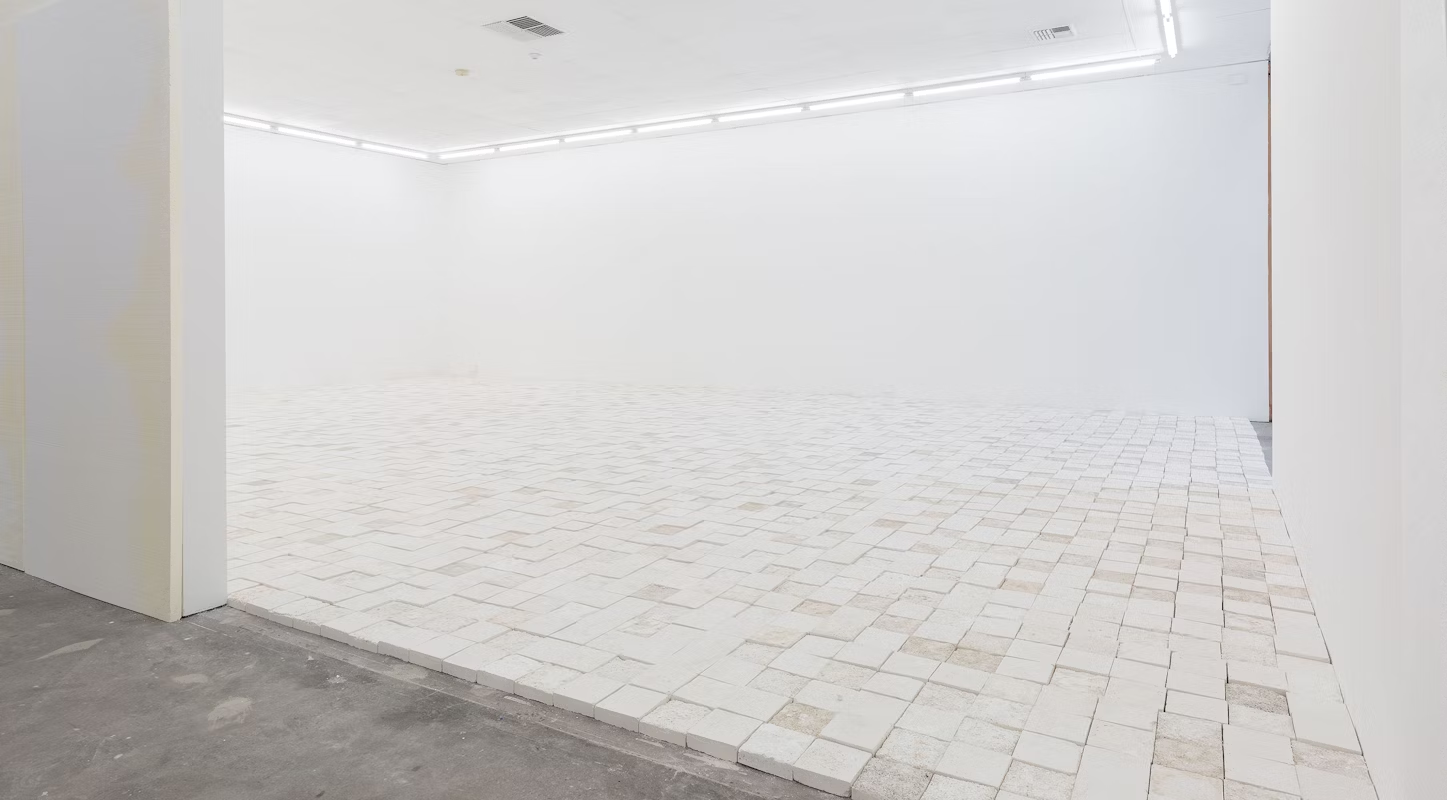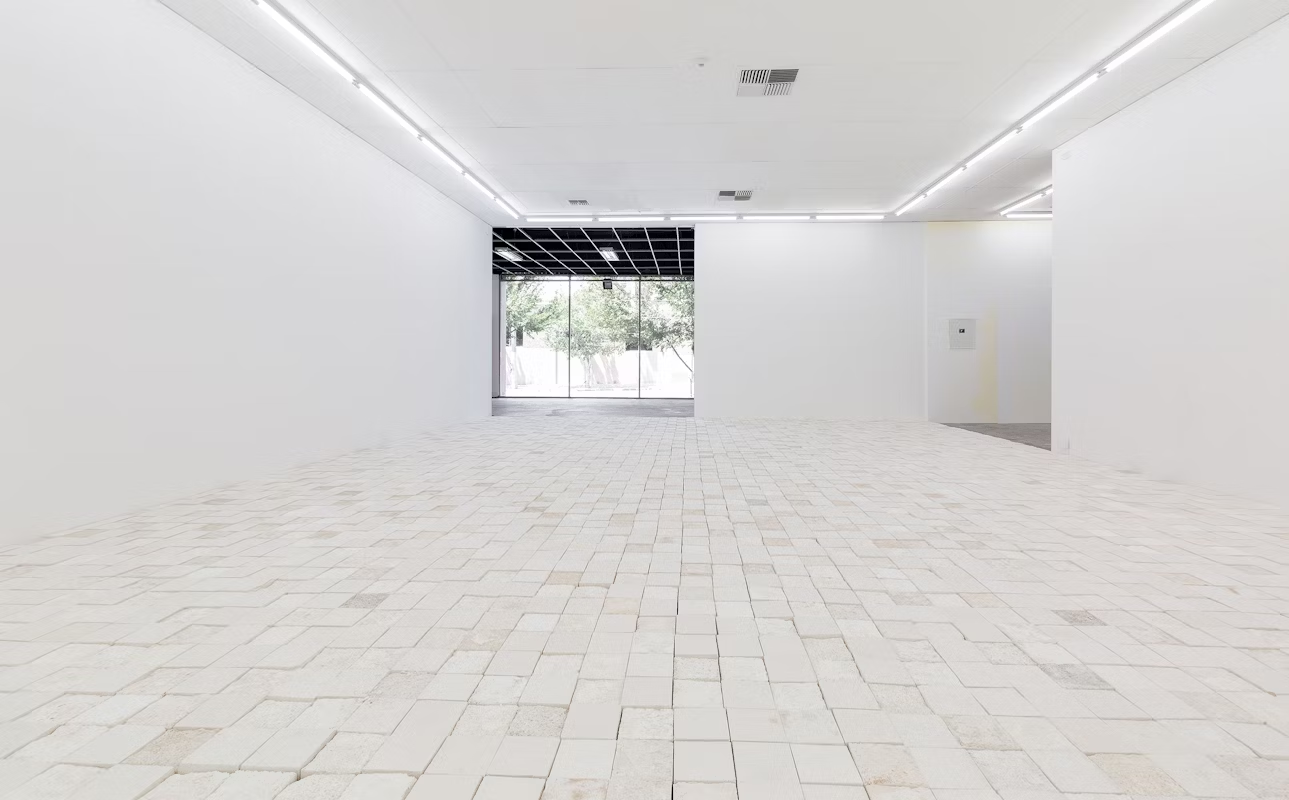Marmoreum
Amy May Stuart
I visited Sarah Ujmaia’s exhibition Marmoreum twice—initially for the opening, and again for a proper look several weeks later. Not much had changed between visits, or so I thought. The almost four thousand white hand-cast paving stones were still laid in place across the entire gallery floor, moving slightly with a gentle clinking sound as I walked across them. En masse, the pavers seem relatively uniform—15 × 15 × 4 centimetre blocks of mineral calcite, punctuated by slight variations in colour and texture. The gallery’s fluorescent lights were reflected by the bright white walls and floor to dazzling effect.
On the occasion of this second viewing, however, I accidentally crashed a Monash post-graduate group critique session and ended up sitting next to someone on the floor. From this new vantage point, I realise that despite its static appearance, this work is actually eroding beneath our feet, the edges of the pavers are crumbling into fragments and dust, which sticks to our hands and clothes. Down here I also notice that, while some blocks are quite smooth and plaster-like, others contain small bits of shell and crushed up-material, all of which is slowly accumulating in the narrow gaps between each paver alongside strands of hair and other detritus unknowingly shed by visitors.
Marmoreum’s exhibition text informs me that the title draws from the adjectival “marmoreal,” to be made from marble or to be marble-like, and that Ujmaia has conceived the work as “to have the material possibility of a marble floor” through her large-scale production of mineral calcite from bisque eggshell, shell grit, and gypsum. This chalk or limestone-like conglomerate could be read along biogeomorphic lines, whereby the calcium carbonate biomineralised by organisms to form structures like shell, bone, or carapace flows from the biosphere to the lithosphere. Through this sedimentation process, the original biological material becomes rock. This material holds marmoreal potential, metamorphosing into marble under certain conditions of fantastic heat, pressure, and time. Ujmaia’s title also alludes to this potential, recalling the Latin suffix “-torium,” as in auditorium or crematorium, used to form a noun denoting a place where a certain activity occurs: Marmoreum, a place of marble metamorphosis.

This chalk floor, then, could be understood as a momentary glimpse of something seemingly fixed yet ultimately in flux. In the end, all the world’s marble, widely held to be a prestigious and hard-wearing material used in various human endeavours, will eventually become eroded or subducted back into the earth’s core. The prospect is dizzying, but highlights the history and endurance of the work’s material outside of the exhibition in both time and space.
This material reconfiguration holds on a human timescale too, as the calcite pavers are eroded by and adhere to visitors who actively cross the floor. The exhibition text notes that the First Law of Thermodynamics (that energy cannot be created nor destroyed) is manifest in Ujmaia’s material choices, and connects this with her ongoing engagement with language loss and diasporic experiences. A link between Marmoreum’s pavers and these experiences is also drawn, whereby the work recalls the cobbled market squares of northern Iraq—the homeland of Ujmaia’s Chaldean family. The text states, “the chalk floor invites the valuing of something that remains changing, locating us as active participants in the future of language.” By drawing attention to this particular moment in marble formation, Ujmaia orchestrates an intersection between biological and geological forces, as well as questioning the seeming permanence of marble itself.
While my personal diasporic experience is not tied to forced displacement as with Ujmaia, a metaphorical reading of the chalk dust resonates with me as my futile attempts to learn the language of my family through my mum’s side. Despite so much time and effort spent with this language, it seems like only minute particles and fragments stick for a time, before rubbing off and vanishing. These ephemeral encounters with the language recall chalk when it is used as a drawing material or writing instrument, particularly in pedagogical settings, where it is always fated to be dusted away. In the context of forced displacement, however, this reading has much more gravity. Diasporic peoples may not be afforded the luxury of returning to their homelands, or access to communities and places where their languages are spoken, let alone feel this language accrete over time.

Although I’ve proposed the above connection between the material of Marmoreum and Ujmaia’s investigation into language, the work invites many readings—not all of which seem available to all visitors. While the exhibition is named Marmoreum, the room sheet indicates that the work itself also has a title: And thank you to my baba for laying the timber floor. Like this calcite floor existing as but one moment in an endless flow of material, this phrase seems cut from a longer address, a flow of language towards an unknown audience. The incongruity of this named timber floor in relation to the chalk one we are standing on furthers the sense that perhaps we aren’t privy to this conversation—it must be another floor, somewhere else, that is being referred to. In any case, one is left guessing: who is speaking, and to whom? Who is baba? The deliberate absence of an answer seems important here, sometimes things are not for everyone to know.
This opacity recalls a recent collaborative artwork, HuiHụi, made by Vietnamese-Australian artist James Nguyen and Māori artist Tamsen Hopkinson (Ngāti Kahungunu, Ngāti Pāhauwera), exhibited in Nguyen’s 2023 Open Glossary at the Australian Centre for Contemporary Art. While Marmoreum and HuiHụi also share some formal elements—the latter comprised in part a large white ash-painted square on the gallery floor, along with sedge mats painted grey—it is a description by Nguyen that resonates with my reading of Ujmaia’s work here. While both Nguyen and Hopkinson’s practices are inextricably linked with their respective cultural heritages, Nguyen outlines part of their decision-making process in the development of HuiHụi, citing a shared experience of “asymmetric voyeurism and cultural exploitation” when bringing culturally significant materials into the contemporary art gallery. He explains, “We deliberately decided against putting our bodies, our families, and our cultural materials on overt display.” This evasive tactic is certainly warranted, given both the proclivity of both historical and contemporary arts institutions in this country to actively participate in and feed off the voyeurism and exploitation that Nguyen identifies. While attitudes towards the display of art and culturally significant materials by non-white practitioners may have shifted over time, in the current moment there exists an insidious demand for certain kinds of visibility, a performance of palatable Otherness that is wholly legible to all—particularly towards marginalised cultures.
This exoticising demand is often framed as a celebratory multiculturalism, and a refusal to comply is seen as ungenerous or an inauthentic cultural expression, whatever that means. No wonder, then, that Nguyen and Hopkinson employed a method of material abstraction in HuiHụi, while retaining more overt linguistic and conceptual ties to their respective and shared cultural heritages. Further enacting their agency over the legibility of the artwork, and aligned with its conceptual concerns, in early November the artists intervened in the installation in response to the contemporaneous escalation of violent settler-colonialism and genocide perpetrated by the Israeli state against Palestinians in Gaza. Alongside a statement of solidarity, Nguyen and Hopkinson painted over the work and turned out the lights, both obfuscating the original installation and presenting a new development at once.

I see this negotiation of legibility, in relation to both this exoticising imperative as well as language more generally, as a possible thread running through Ujmaia’s recent studio practice and continuing in Marmoreum. In the exhibition catalogue for Ujmaia’s Of Particle and Wave (2023, Heide Museum of Modern Art), curator Laura Lantieri notes the multivalence of the works and quotes Ujmaia, writing: “The artist embraces this open-endedness, noting ‘not everything contained within a work can be viewed or accessed by those who are viewing and (potentially) influencing (it). While visual language is visual, it’s not always all visible.’”
In Of Particle and Wave Ujmaia presented a series of darkly rendered graphite drawings, sourced from her photographs taken at the Syriac Heritage Museum in Ankawa, Iraq, alongside dozens of terracotta coils, replicated by hand not unlike Marmoreum’s chalk pavers. Though the drawings depict recognisable objects laid down in graphite pencil (actually a mixture of graphite and a clay binder), such as a lock, coins, or a jug, their everydayness affords them an openness of association. In the same exhibition catalogue, Lucreccia Quintanilla writes on the works in a way that I think also holds resonance for Marmoreum. It is worth quoting at length:
I have begun to see the images in Ujmaia’s works as words or syllables in a sentence, but at the same time I resist my impulse to want to perceive them as a full sentence and acknowledge—it is I who needs to adapt to their plurality. In fact, there is no lack of legibility in the language that these objects—which are also drawings—belong to. They speak very fluently, very confidently in their fragmentary form, in their mix of memory and history and belonging to the world now. As individual components, in their unfinished-ness, the sentence is still functional.
While the pavers of And thank you to my baba for laying the timber floor hold a direct reference to the northern Iraqi paved marketplaces as one of many associations, considering this within the context of Ujmaia’s oeuvre and Quintanilla’s reflections prompts me to consider the subjectiveness and demands of my readings. Knowledge is being retained, reconfigured, and communicated here, though one’s access to this is always mediated and not guaranteed. Marmoreum is wholly legible in its own right as a visual language, and Ujmaia achieves an incredible complexity of material and conceptual inquiry through a seemingly simple replicated form.
Amy Stuart is an artist living in Naarm/Melbourne.


